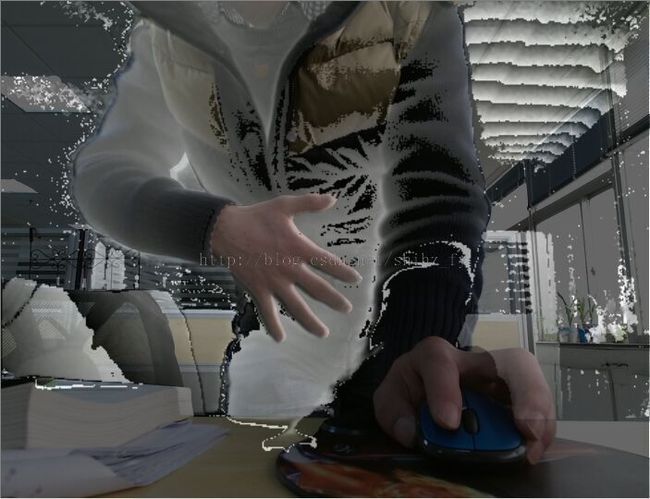Kinect深度图与彩色图的坐标校准
kinect的深度数据和彩色数据的分辨率以及视场大小都不一样,不能直接对应起来,想要把深度和彩色融合起来就要费一番周折了。
看了MSDN中kinectSDK的介绍,发现了一个ICoordinateMapper的类,看介绍知道里面有一个成员函数MapDepthFrameToColorSpace可以实现深度图和彩色图的坐标校准,于
想试试看,结果转到定义处才发现这个成员函数是纯虚函数!!白高兴一场了,想了想也没有找到一个合适的方法来更好的实现,于是就想手动校准好了。
接下来就是先用规则的长方体来测一下在深度图和彩色图中的同一边长的比例,为了测量更加准确,就把深度图同一时间的深度图和彩色图给截图下来,然后通过matlab来实现坐标显示,来得到同一位置长方体的同一边长,通过求几组数据的平均得到深度图和彩色图的比例,这样,在使用opencv的resize函数便将深度图和彩色图的比例调整为1:1了。最后通过将同一点在深度图和彩色图中的坐标关系来将两种图的坐标关系对应好,这样便实现了坐标的对应,通过opencv的ROI来将两幅图重合的部分裁剪下来,并且在同一幅画面中显示。
下面是一个效果图:
/***** Measurement of height by kinect ******/
/***** VisualStudio 2012 (开发工具)
OpenCV2.4.8 (显示界面库 vc11库)
KinectSDK-v2.0-PublicPreview1409-Setup (Kinect SDK驱动版本)
Windows 8.1 (操作系统) ******/
/***** shihz ******/
/***** 2015-2-7 ******/
#include"stdafx.h"
#include "opencv2/opencv.hpp"
#define Y 160
using namespace cv;
// Safe release for interfaces
template<class Interface>
inline void SafeRelease(Interface *& pInterfaceToRelease)
{
if (pInterfaceToRelease != NULL)
{
pInterfaceToRelease->Release();
pInterfaceToRelease = NULL;
}
}
//定义Kinect方法类
class Kinect
{
public:
static const int cDepthWidth = 512; //深度图的大小
static const int cDepthHeight = 424;
static const int cColorWidth = 1920; //彩色图的大小
static const int cColorHeight = 1080;
Mat showImageDepth;
HRESULT InitKinect();//初始化Kinect
void UpdateDepth();//更新深度数据
void UpdateColor();//更新深度数据
void ProcessDepth(const UINT16* pBuffer, int nWidth, int nHeight, USHORT nMinDepth, USHORT nMaxDepth); //处理得到的深度图数据
void ProcessColor(RGBQUAD* pBuffer, int nWidth, int nHeight); //处理得到的彩色图数据
Kinect(); //构造函数
~Kinect(); //析构函数
private:
IKinectSensor* m_pKinectSensor;// Current Kinect
IDepthFrameReader* m_pDepthFrameReader;// Depth reader 在需要的时候可以再添加IColorFrameReader,进行color reader
RGBQUAD* m_pDepthRGBX;
IColorFrameReader* m_pColorFrameReader;// Color reader
RGBQUAD* m_pColorRGBX;
};
int main()
{
Kinect kinect;
Mat showImageColor;
kinect.InitKinect();
while(1)
{
kinect.UpdateColor(); //程序的中心内容,获取数据并显示
kinect.UpdateDepth();
if(waitKey(1) >= 0)//按下任意键退出
{
break;
}
}
return 0;
}
Kinect::Kinect()
{
m_pKinectSensor = NULL;
m_pColorFrameReader = NULL;
m_pDepthFrameReader = NULL;
m_pDepthRGBX = new RGBQUAD[cDepthWidth * cDepthHeight];// create heap storage for color pixel data in RGBX format ,开辟一个动态存储区域
m_pColorRGBX = new RGBQUAD[cColorWidth * cColorHeight];// create heap storage for color pixel data in RGBX format
}
Kinect::~Kinect() //定义析构函数
{
if (m_pDepthRGBX)
{
delete [] m_pDepthRGBX; //删除动态存储区域
m_pDepthRGBX = NULL;
}
SafeRelease(m_pDepthFrameReader);// done with depth frame reader
if (m_pColorRGBX)
{
delete [] m_pColorRGBX;
m_pColorRGBX = NULL;
}
SafeRelease(m_pColorFrameReader);// done with color frame reader
if (m_pKinectSensor)
{
m_pKinectSensor->Close();// close the Kinect Sensor
}
SafeRelease(m_pKinectSensor);
}
HRESULT Kinect::InitKinect() //定义初始化kinect函数
{
HRESULT hr; //typedef long HRESULT
hr = GetDefaultKinectSensor(&m_pKinectSensor); //获取默认的kinect,一般来说只有用一个kinect,所以默认的也就是唯一的那个
if (FAILED(hr)) //Failed这个函数的参数小于0的时候返回true else 返回false
{
return hr;
}
if (m_pKinectSensor)
{
// Initialize the Kinect and get the depth reader
IDepthFrameSource* pDepthFrameSource = NULL;
IColorFrameSource* pColorFrameSource = NULL;
hr = m_pKinectSensor->Open();
if (SUCCEEDED(hr))
{
hr = m_pKinectSensor->get_ColorFrameSource(&pColorFrameSource);
hr = m_pKinectSensor->get_DepthFrameSource(&pDepthFrameSource);
}
if (SUCCEEDED(hr))
{
hr = pColorFrameSource->OpenReader(&m_pColorFrameReader);
hr = pDepthFrameSource->OpenReader(&m_pDepthFrameReader); //初始化Depth reader,传入该IDepthReader的地址,让该指针指向深度数据流
}
SafeRelease(pColorFrameSource);
SafeRelease(pDepthFrameSource);
}
if (!m_pKinectSensor || FAILED(hr))
{
printf("No ready Kinect found! \n");
return E_FAIL;
}
return hr;
}
void Kinect::UpdateDepth()
{
if (!m_pDepthFrameReader)
{
return;
}
IDepthFrame* pDepthFrame = NULL;
HRESULT hr = m_pDepthFrameReader->AcquireLatestFrame(&pDepthFrame);
if (SUCCEEDED(hr))
{
IFrameDescription* pFrameDescription = NULL;
int nWidth = 0;
int nHeight = 0;
USHORT nDepthMinReliableDistance = 0;
USHORT nDepthMaxDistance = 0;
UINT nBufferSize = 0;
UINT16 *pBuffer = NULL;
if (SUCCEEDED(hr))
{
hr = pDepthFrame->get_FrameDescription(&pFrameDescription);
}
if (SUCCEEDED(hr))
{
hr = pFrameDescription->get_Width(&nWidth);
}
if (SUCCEEDED(hr))
{
hr = pFrameDescription->get_Height(&nHeight);
}
if (SUCCEEDED(hr))
{
hr = pDepthFrame->get_DepthMinReliableDistance(&nDepthMinReliableDistance);
}
if (SUCCEEDED(hr))
{
// In order to see the full range of depth (including the less reliable far field depth)
// we are setting nDepthMaxDistance to the extreme potential depth threshold
nDepthMaxDistance = USHRT_MAX;
// Note: If you wish to filter by reliable depth distance, uncomment the following line.
// hr = pDepthFrame->get_DepthMaxReliableDistance(&nDepthMaxDistance);
}
if (SUCCEEDED(hr))
{
hr = pDepthFrame->AccessUnderlyingBuffer(&nBufferSize, &pBuffer);
}
if (SUCCEEDED(hr))
{
ProcessDepth( pBuffer, nWidth, nHeight, nDepthMinReliableDistance, nDepthMaxDistance);
}
SafeRelease(pFrameDescription);
}
SafeRelease(pDepthFrame);
}
void Kinect::UpdateColor()
{
if (!m_pColorFrameReader)
{
return;
}
IColorFrame* pColorFrame = NULL;
HRESULT hr = m_pColorFrameReader->AcquireLatestFrame(&pColorFrame);
if (SUCCEEDED(hr))
{
IFrameDescription* pFrameDescription = NULL;
int nWidth = 0;
int nHeight = 0;
ColorImageFormat imageFormat = ColorImageFormat_None;
UINT nBufferSize = 0;
RGBQUAD *pBuffer = NULL;
if (SUCCEEDED(hr))
{
hr = pColorFrame->get_FrameDescription(&pFrameDescription);
}
if (SUCCEEDED(hr))
{
hr = pFrameDescription->get_Width(&nWidth);
}
if (SUCCEEDED(hr))
{
hr = pFrameDescription->get_Height(&nHeight);
}
if (SUCCEEDED(hr))
{
hr = pColorFrame->get_RawColorImageFormat(&imageFormat);
}
if (SUCCEEDED(hr))
{
if (imageFormat == ColorImageFormat_Bgra)
{
hr = pColorFrame->AccessRawUnderlyingBuffer(&nBufferSize, reinterpret_cast<BYTE**>(&pBuffer));
}
else if (m_pColorRGBX)
{
pBuffer = m_pColorRGBX;
nBufferSize = cColorWidth * cColorHeight * sizeof(RGBQUAD);
hr = pColorFrame->CopyConvertedFrameDataToArray(nBufferSize, reinterpret_cast<BYTE*>(pBuffer), ColorImageFormat_Bgra);
}
else
{
hr = E_FAIL;
}
}
if (SUCCEEDED(hr))
{
ProcessColor(pBuffer, nWidth, nHeight);
}
SafeRelease(pFrameDescription);
}
SafeRelease(pColorFrame);
}
void Kinect::ProcessDepth(const UINT16* pBuffer, int nWidth, int nHeight, USHORT nMinDepth, USHORT nMaxDepth )
{
// Make sure we've received valid data
if (m_pDepthRGBX && pBuffer && (nWidth == cDepthWidth) && (nHeight == cDepthHeight))
{
RGBQUAD* pRGBX = m_pDepthRGBX;
// end pixel is start + width*height - 1
const UINT16* pBufferEnd = pBuffer + (nWidth * nHeight);
while (pBuffer < pBufferEnd)
{
USHORT depth = *pBuffer;
// To convert to a byte, we're discarding the most-significant
// rather than least-significant bits.
// We're preserving detail, although the intensity will "wrap."
// Values outside the reliable depth range are mapped to 0 (black).
// Note: Using conditionals in this loop could degrade performance.
// Consider using a lookup table instead when writing production code.
BYTE intensity = static_cast<BYTE>((depth >= nMinDepth) && (depth <= nMaxDepth) ? (depth % 256) : 0); //深度数据由黑白图像显示//,每256个单位是一个有黑到白的周期
pRGBX->rgbRed = intensity;
pRGBX->rgbGreen = intensity;
pRGBX->rgbBlue = intensity;
++pRGBX;
++pBuffer;
}
// Draw the data with OpenCV
Mat DepthImage(nHeight, nWidth, CV_8UC4, m_pDepthRGBX);
Mat show = DepthImage.clone();
resize(DepthImage, show, Size(cDepthWidth*1.437 , cDepthHeight*1.437));
showImageDepth = show.clone();
imshow("DepthImage", show);
}
}
void Kinect::ProcessColor(RGBQUAD* pBuffer, int nWidth, int nHeight)
{
// Make sure we've received valid data
if (pBuffer && (nWidth == cColorWidth) && (nHeight == cColorHeight))
{
// Draw the data with OpenCV
Mat ColorImage(nHeight, nWidth, CV_8UC4, pBuffer);
Mat showImage = ColorImage.clone();
resize(ColorImage, showImage, Size(nWidth/2 , nHeight/2));
Rect rect(145,0,702,538);
int x = 33,y =-145;
//CV_8UC4
for(int i = 0;i <540;i++)
for(int j = 145;j < 960-114;j++)
showImage.at<Vec4b>(i,j) = showImageDepth.at<Vec4b>(i+x,j+y)*0.6+showImage.at<Vec4b>(i,j)*0.4;
Mat image_roi = showImage(rect);
//imshow("ColorImage", showImage);//imshow("ColorImage", ColorImage);
imshow("Image_Roi", image_roi);
}
}
